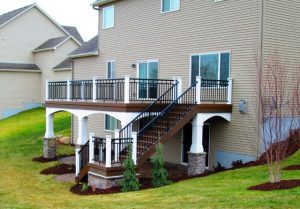Diamond Home Inspections | Home Inspection 612-223-5387

According to the North American Deck and Railing Association (NADRA), there are more than 50 million decks in the United States, half of which may be well past their prime. After all, building codes, construction methods, and decking materials have changed considerably in the last two decades. And since decks are outdoor structures, they are always at the mercy of weather and extreme temperature fluctuations which, over time, can lead to structural breakdowns. Wood decks, in particular, are susceptible to cracking, splintering, warping, and insect infestation.
When choosing your dream home, this is one area you do not want to over look. Our inspector will provide a excellent and thorough inspection to keep your family safe!
5 areas our inspector will look at when inspecting your deck:
1. Inspect the wood
- The inspector will inspect several areas of your deck to ensure the wood is still sound, including:
- The ledger board
- Support posts and joists beneath the deck
- Deck boards, railing, and stairs – unless you have decay-resistant composite decking
- Look for small holes in the wood or evidence of sawdust/wood dust. If any are present, it may be an indication of insect infestation.
- Examine any areas that are regularly exposed to water, tend to remain damp, or are in regular contact with fasteners. If you can easily penetrate the wood or if the wood is soft and spongy, you might have wood decay.
2. Inspect your flashing to ensure-
- Proper installation of ledger board flashing
- Flashing works to prevent moisture and debris from collecting between the house and the ledger board.
- Flashing is installed behind the siding and over the top of the ledger board.
- Flashing runs the entire length of the ledger board and be free of any nail or screw holes.
- No water is collecting anywhere
3. Check your fasteners
- If you have wood decking the inspector will check for popped nails
- Any loose screws.
- Look for rusted or corroded fasteners
4. Railings
- The inspector will check the deck railings as this is one of the main reasons for injuries from rail failures.
- The inspector will push on your railing to ensure it doesn’t “give” in any way.
- Ensure your rail complies with local building codes. That means a rail height of 36”, as per the International Residential Code (IRC). However, 42” rail heights may be required in some states, as well as for commercial applications, as per the International Building Code (IBC).
- Measure the spacing between balusters. To prevent small children and pets from squeezing through, the distance between each baluster cannot exceed 4” for line sections and 4-3/8” for stairs. What’s more, the “triangle” created by the stair tread, riser, and guardrail cannot be large enough to allow a 6” sphere to pass through.
5. Electrical Areas
- The inspector will check all electrical outlets, appliances and features must be code-compliant, childproof (if you have children or young visitors), and in good condition.
- If electrical cords are present on the deck, the inspector will ensure they do not present a tripping hazard.
The bottom line: safety first. No matter how beautiful or well-built your deck may be, an annual check-up is always in order. Call us today for all your deck inspection needs.
Diamond Home Inspections | Home Inspection 612-223-5387